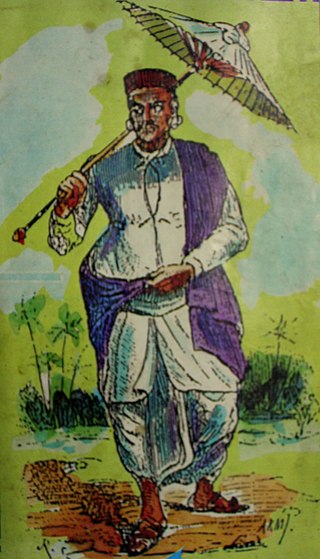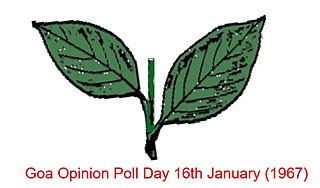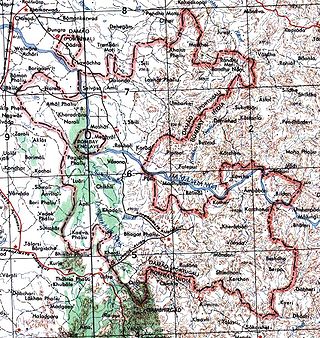Related Research Articles

Vindaloo or Vindalho is an Indian curry dish, originally from Vasai and Goa.

The history of Goa dates back to prehistoric times, though the present-day state of Goa was only established as recently as 1987. In spite of being India's smallest state by area, Goa's rich history is both long and diverse. It shares a lot of similarities with Indian history, especially with regard to colonial influences and a multi-cultural aesthetic.
The Konkani people are an Indo-Aryan ethnolinguistic group native to the Konkan region of the Indian subcontinent who speak various dialects of the Konkani language. Konkani is the state language of Goa and also spoken by populations in Karnataka, Maharashtra, Damaon and Kerala. Other Konkani speakers are found in Gujarat state. A large percentage of Konkani people are bilingual.

Antonio Francisco Xavier Alvares was initially a priest in the Roman Catholic Church in Goa. He joined the Malankara orthodox syrian church and was elevated to Metropolitan of Goa, Ceylon and Greater India in the Malankara Orthodox syian Church.
Goans is the demonym used to describe the people native to Goa, India, who form an ethno-linguistic group resulting from the assimilation of Indo-Aryan, Dravidian, Indo-Portuguese, Austro-Asiatic ethnic and/or linguistic ancestries. They speak different dialects of the Konkani language, collectively known as Goan Konkani. "Goanese", although sometimes used, is an incorrect term for Goans.

The Daivadnya,, is a community from Goa and Karnataka, who claim to have descended from Vishwakarma. Although they claim themselves to be Brahmin, but these claims are not accepted by others including local Brahmin castes. They are native to the Konkan and are mainly found in the states of Goa and Damaon, Canara, coastal Maharashtra, and Kerala. Daivadnyas in the state of Karnataka are classified by National Commission for Backward Classes as an Other Backward Class.

Waman Raghunath Shennoi Varde Valaulikar, popularly known as Shenoi Goembab, was a Goan writer and activist of the Konkani language.

Deknni is a semi classical Goan dance form. The plural of dekṇi in Konkani remains the same.

The Annexation of Goa was the process in which the Republic of India annexed the Portuguese State of India, the then Portuguese Indian territories of Goa, Daman and Diu, starting with the armed action carried out by the Indian Armed Forces in December 1961. In India, this action is referred to as the "Liberation of Goa". In Portugal, it is referred to as the "Invasion of Goa". Jawaharlal Nehru had hoped that the popular movement in Goa and the pressure of world public opinion would force the Portuguese Goan authorities to grant it independence, but without success; consequently, Krishna Menon suggested taking Goa by force.
Goan cuisine consists of regional foods popular in Goa, an Indian state located along India's west coast on the shore of the Arabian Sea. Rice, seafood, coconut, vegetables, meat, bread, pork and local spices are some of the main ingredients in Goan cuisine. Use of kokum and vinegar is another distinct feature. Goan food is considered incomplete without fish.

Tristão de Bragança Cunha, alternatively spelled as Tristao de Braganza Cunha, popularly known as T B Cunha was a prominent Goan nationalist and anti-colonial activist from Goa. He is popularly known as the "Father of Goan nationalism", and was the organiser of the first movement to end Portuguese rule in Goa.

Tiatr is a type of musical theatre that is popular in the state of Goa on the west coast of India, as well as in Mumbai and among expatriate communities in the Middle East, United Kingdom, and other cities with a significant presence of Konkani speakers. The dramas are primarily performed in the Romi Konkani dialects and incorporate elements such as music, dance, and singing. Individuals who perform in tiatr are referred to as tiatrists.

The 1967 Goa status referendum popularly known as the Goa Opinion Poll was a referendum held in newly annexed union territory of Goa and Damaon in India, on 16 January 1967, to deal with the Konkani language agitation and to decide the future of Goa.
Captain Alvaro de Loyola Furtado BS WM OM, popularly known as Dr. Alu, was a former member of the Goa, Daman and Diu Legislative Assembly and one of the founding members of the United Goans Party. He was also a social worker, historian, journalist, medical practitioner and humanitarian. Described as a leader among men, a man of great integrity and honour.
The Goa liberation movement was a movement which fought to end Portuguese colonial rule in Goa, Portuguese India. The movement built on the small scale revolts and uprisings of the 19th century, and grew powerful during the period 1940–1961. The movement was conducted both inside and outside Goa, and was characterised by a range of tactics including nonviolent demonstrations, revolutionary methods and diplomatic efforts. However, Portuguese control of its Indian colonies ended only when India invaded and annexed Goa in 1961, causing a mixture of worldwide acclaim and condemnation, and incorporated the territories into India.

The Annexation of Dadra and Nagar Haveli was the conflict in which the territories of Dadra and Nagar Haveli passed from Portuguese rule to independent rule, with Indian allegiance, in 1954.

Luso-Indians or Portuguese-Indian, is a subgroup of the larger Eurasian multiracial ethnic creole people of Luso-Asians. Luso-Indians are people who have mixed Indian and Portuguese ancestry or people of Portuguese descent born or living or originating in former Portuguese Indian colonies, the most important of which were Goa and Damaon of the Konkan region in the present-day Republic of India, and their diaspora around the world, the Anglosphere, Lusosphere, the Portuguese East Indies such as Macao etc.

Special Status for Goa is a proposal to make the Goa state as an entity with additional powers within the Indian Union. Proponents of the idea have argued that Government of Goa should be given certain powers by the Indian Government by amending Article 371I of the Constitution of India, to preserve the unique culture and history of this subregion of Konkan. These powers would allow the Government of Goa to enact legislation to protect the private property rights of the Goans and put restrictions on the sale of land by Goans.

Goa is a state on the southwestern coast of India within the Konkan region, geographically separated from the Deccan highlands by the Western Ghats. It is bound by the Indian states of Maharashtra to the north, and Karnataka to the east and south, with the Arabian Sea in the west. It is India's smallest state by area and fourth-smallest by population. Goa has the highest GDP per capita among all Indian states, two and a half times as high as the GDP per capita of the country as a whole. The Eleventh Finance Commission of India named Goa the best-placed state because of its infrastructure, and India's National Commission on Population rated it as having the best quality of life in India. It is the second-highest ranking among Indian states in the human development index.

The Portuguese controlled Goa until 1961, when India took over. Only a very small fraction of Goans speak Portuguese nowadays. Although an essential religious language, there were 1,500 students learning Portuguese in Goa in 2015; totaling a number of 10,000 – 12,000 Portuguese speakers in the state.
References
- ↑ Kamat, Pratima. 1999: 183.